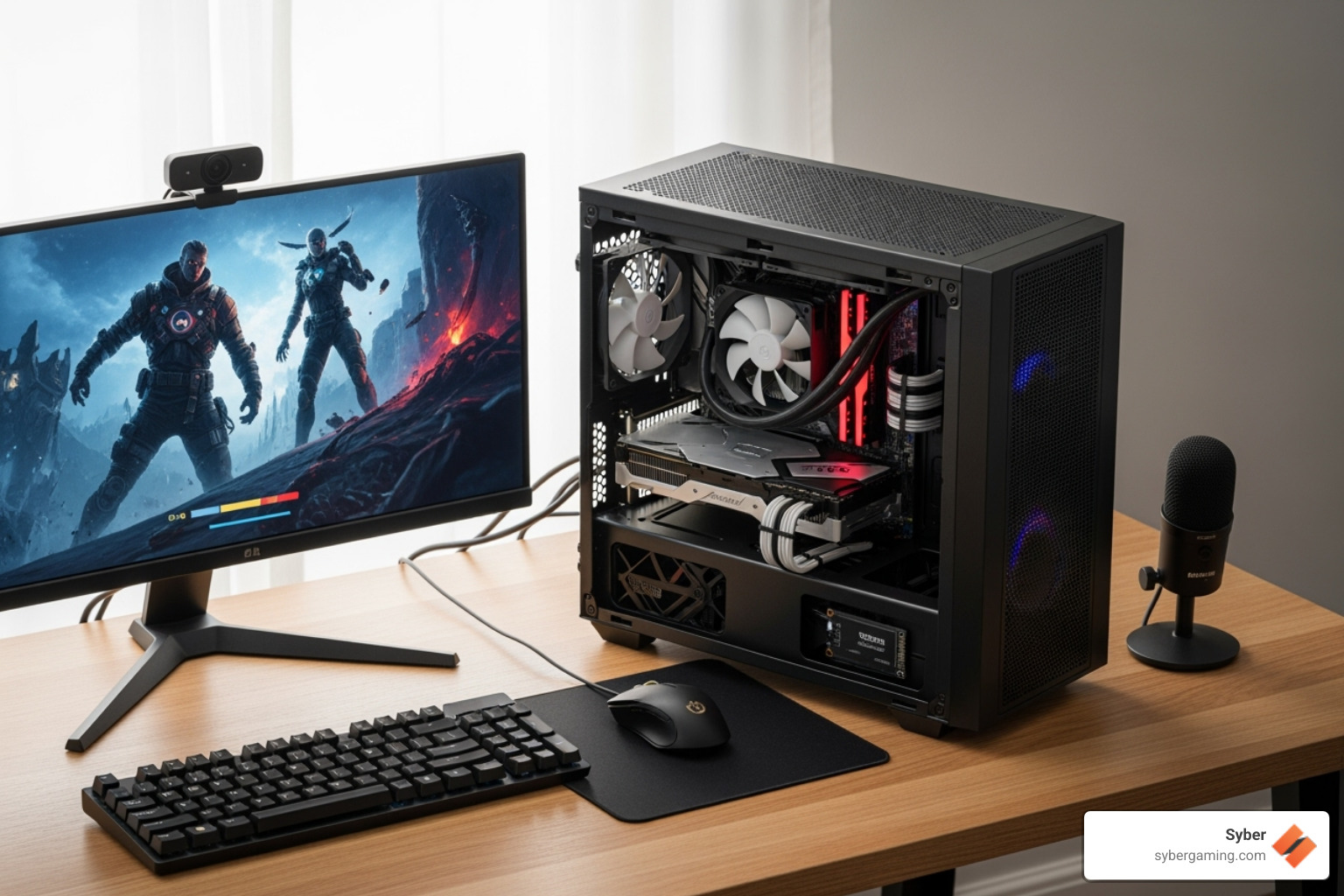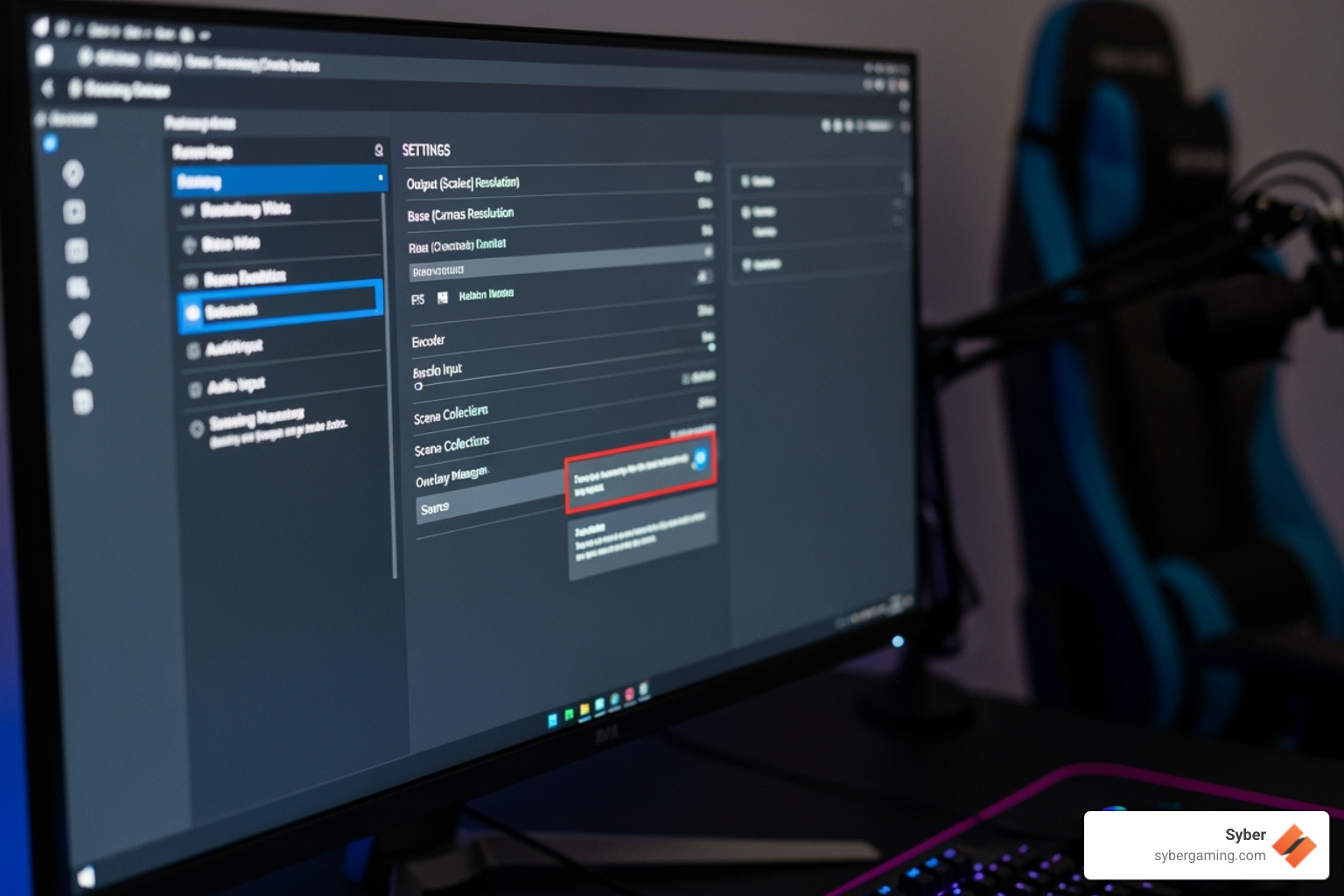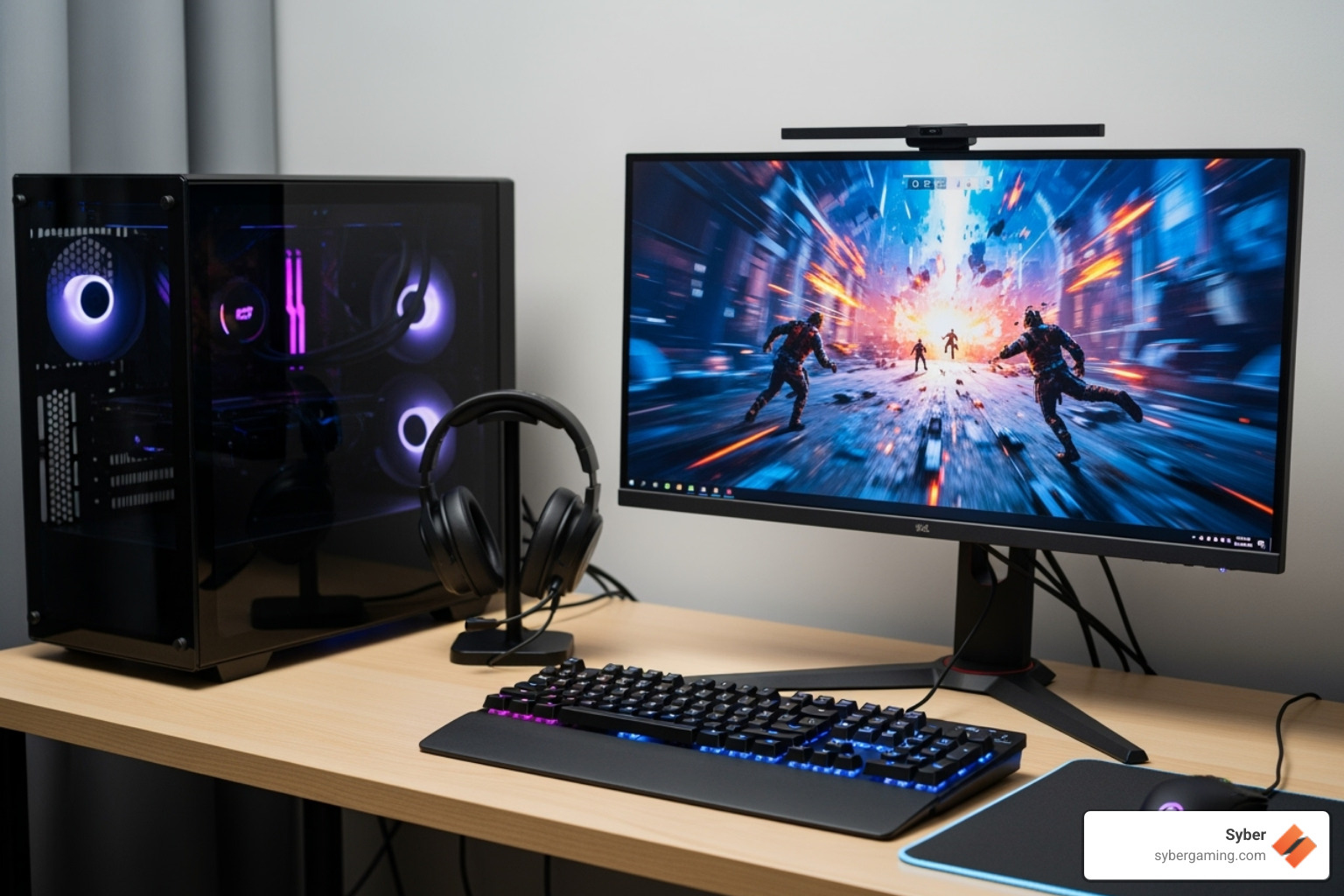Striking the Perfect Balance Between Gaming and Streaming
Finding the right budget for a good streaming gaming computer is a common goal for aspiring and established content creators. The challenge lies in building a machine that can simultaneously run demanding, graphically-intensive games at high frame rates while encoding and broadcasting a high-quality live video feed to an audience. These two tasks compete for the same system resources, and a standard gaming PC can often struggle under the combined load, resulting in stuttering gameplay or a pixelated, unstable stream. A dedicated streaming PC must be more than just a powerful gaming machine; it needs to be a multitasking workhorse.
To achieve this balance, a thoughtful approach to selecting components is necessary. Each part plays a critical role in the dual-purpose nature of the build. Here is a brief overview of the core components and their function in a streaming context:
- CPU (Central Processing Unit): The CPU manages the game's logic, the operating system, and background applications like chat programs. In some cases, it may also handle stream encoding, making a processor with multiple cores and threads essential for smooth multitasking.
- GPU (Graphics Processing Unit): The GPU is responsible for rendering the visuals of the game you are playing. Modern GPUs also contain dedicated hardware encoders that are specifically designed to handle video encoding for streaming with minimal impact on game performance.
- RAM (Random Access Memory): RAM acts as the short-term memory for your system. Having enough RAM is crucial to run a game and streaming software at the same time without performance degradation.
- Storage (Solid State Drive): An SSD provides fast access to your games and applications, leading to significantly reduced loading times and a more responsive system overall.
The good news is that advancements in computer hardware have made it possible to build a capable streaming and gaming setup without an enormous financial investment. This guide will walk you through the process of allocating your budget effectively, helping you select the right components to create a reliable, high-performance desktop PC for a seamless gaming and streaming experience.

The Core Components: Budgeting for a High Performance Gaming PC Build
When establishing the budget for a good streaming gaming computer, a deep understanding of each component's function is vital. A well-balanced PC is a synergistic team of parts, and making informed choices ensures you get the maximum performance for every dollar spent. Knowing where to invest more and where you can save allows you to assemble a high performance gaming PC build that not only meets today's demanding standards but is also prepared for future upgrades.

The Brains & Brawn: Choosing Your CPU and GPU for AI-Improved Gaming
Your CPU and GPU are the heart of your gaming pc high performance setup. The CPU acts as the brain, handling game logic, physics calculations, and background tasks. The GPU is the muscle, rendering the millions of pixels that create the visual world of your game. For streaming, both components take on additional responsibilities. A CPU with a higher core count (six or more) is highly recommended, as it can better manage the game, the operating system, and streaming software simultaneously without becoming a bottleneck. Processors like the AMD Ryzen 5 series or the Intel Core i5 series provide an excellent balance of price and multi-core performance for this purpose.
The GPU choice is arguably the most critical for a streaming PC. While its primary job is to deliver high frame rates in-game, its secondary role in stream encoding is a game-changer. NVIDIA's GeForce RTX series GPUs (like the RTX 3060 or 4060) are widely favored by streamers due to their dedicated NVENC hardware encoder. This is a separate part of the GPU chip that is engineered specifically to compress and encode video, offloading this intensive task from the CPU. The result is a negligible impact on gaming performance, allowing you to maintain high frame rates while broadcasting a clean, stable stream. AMD's GPUs also have a hardware encoder (AMF) and offer strong gaming performance for their price point, with models like the Radeon RX 6600 or 7600 being solid budget-friendly options. Modern GPUs also feature AI-powered graphics technologies like NVIDIA's DLSS or AMD's FSR, which use AI algorithms to boost frame rates, giving you more performance headroom for a higher quality stream.
Memory & Speed: RAM and Storage Essentials for AI Gaming Performance
Memory (RAM) and storage are the crucial supporting elements in a high performance gaming pc build. RAM is the system's active workspace, and for a streaming PC, 16GB of RAM should be considered the minimum. While 8GB might be enough for gaming alone, adding streaming software, a web browser, and other applications will quickly consume it, leading to system-wide slowdowns. 16GB provides the necessary breathing room for smooth multitasking. While 32GB of RAM can be beneficial for heavy video editing or running extremely complex game servers, it is not essential for most gaming and streaming setups. For optimal performance, especially with modern CPUs, look for RAM speeds of at least 3200MHz for DDR4 or 5200MHz for DDR5.
For storage, an NVMe SSD is a requirement for a modern gaming PC. These drives offer incredibly fast read and write speeds, which dramatically reduces operating system boot times and, most importantly, game loading screens. A 1TB NVMe SSD is a great starting point, providing ample space for your OS and a healthy library of your most-played games. As game sizes continue to grow, this capacity ensures you won't have to constantly uninstall and reinstall titles. To supplement this, many builders opt for a secondary, larger SATA SSD (2TB or more) to store stream recordings, video clips, and a backlog of less-frequently played games. This dual-drive configuration offers a perfect blend of speed for active use and cost-effective capacity for mass storage, contributing to superior AI gaming performance.
Here's a look at component tiers for a high performance custom prebuilt gaming pc:
- Essential Specs: Intel Core i5 (12th Gen+) or AMD Ryzen 5 (5000 series+) CPU, NVIDIA GeForce RTX 3050 or AMD Radeon RX 6600 GPU, 16GB DDR4 3200MHz+ RAM, 1TB NVMe SSD, 650W 80+ Bronze PSU.
- Recommended Setup: Intel Core i5 (13th Gen+) or AMD Ryzen 5 (7000 series+) CPU, NVIDIA GeForce RTX 3060/4060 or AMD Radeon RX 6700 XT/7700 XT GPU, 16GB DDR5 5200MHz+ RAM, 1TB NVMe SSD + 2TB secondary storage, 750W 80+ Gold PSU.
The Foundation: Motherboard, Power Supply, and Airflow Cooling
The motherboard, power supply unit (PSU), and cooling system are the foundational components of your build high performance gaming pc. Your motherboard is the central hub that connects everything. When choosing one, ensure it has the correct socket for your CPU (e.g., AM5 for modern AMD, LGA 1700 for modern Intel) and supports your chosen RAM type. For most builds, a B-series chipset motherboard (like B650 for AMD or B760 for Intel) provides all the necessary features, including PCIe 4.0 support for your GPU and NVMe SSD, without the premium cost of higher-end Z/X-series boards. Also, consider the form factor, such as ATX, to ensure it fits in your chosen case. You can learn more about this at Case Confusion: What Does ATX Even Mean?.
Never underestimate the importance of a quality power supply. A reliable PSU is critical for system stability and component longevity. A 650W to 750W unit from a reputable brand will provide plenty of power for a mid-range build with room for future upgrades. Look for a unit with at least an 80 Plus Bronze certification, which guarantees a certain level of power efficiency, reducing wasted energy and heat. An 80 Plus Gold certified PSU is even better for higher-end systems.
Finally, effective airflow cooling is essential to keep your components running at their peak performance. High-performance parts generate heat, and if that heat isn't exhausted efficiently, the components will throttle (slow down) to protect themselves. A quality PC case with a mesh front panel and multiple case fans is the best starting point. A standard configuration involves using front fans as intakes to draw cool air in and rear and top fans as exhausts to push hot air out. While stock CPU coolers can work, a modest investment in an aftermarket air cooler will provide significantly better temperatures and quieter operation. At Syber, we prioritize proven air cooling solutions and meticulous assembly to ensure every system maintains optimal performance under load.
Optimizing Your Rig for a Flawless Streaming Experience
Assembling the right hardware is the first major step, but achieving a professional-quality stream requires mastering system optimization and streaming software settings. Even a powerful PC can produce a choppy stream if it is not configured correctly. By making smart adjustments to your software, you can open up the full potential of your budget for a good streaming gaming computer and deliver an outstanding AI gaming experience for your audience.

Prebuilt vs. Customizable Prebuilt: What's the Best Path for Your Budget?
When planning your budget for a good streaming gaming computer, you will inevitably face the choice between building it yourself (DIY) or purchasing a prebuilt system. For many users, a customizable prebuilt gaming PC from a reputable builder represents the ideal middle ground, combining convenience, guaranteed performance, and excellent value.
The DIY route can be a fulfilling project, but it comes with potential difficulties. Sourcing individual components at competitive prices can be time-consuming, and there is always the risk of parts being incompatible or getting damaged during assembly. Troubleshooting a new build that won't turn on can be a frustrating experience for even seasoned builders. Furthermore, with a DIY build, you are responsible for managing separate warranties for each individual component.
A high performance custom prebuilt gaming PC from a builder like Syber eliminates these issues. Your computer arrives professionally assembled and cable-managed for optimal airflow and aesthetics. We conduct rigorous testing on every machine to ensure it performs perfectly right out of the box. Perhaps most importantly, you receive a comprehensive warranty covering the entire system and have access to a dedicated support team to help with any issues. Because system builders purchase components in bulk, a pre built gaming pc customizable from Syber is often more cost-effective than sourcing the parts yourself, saving you time, money, and stress.
Optimizing Software and Settings for Peak AI-Driven Performance
Once your hardware is ready, software optimization is key to open uping peak AI-driven performance. This starts with your streaming application, such as the popular and free OBS Studio.
- Encoder: This is the most critical setting. Always select your GPU's hardware encoder. For NVIDIA GPUs, choose NVENC (or NVIDIA NVENC H.264). For AMD GPUs, choose AMD HW H.264 (or AMF). This ensures the GPU, not the CPU, handles the stream encoding, preserving your in-game frame rate.
- Resolution and Bitrate: The quality of your stream is determined by resolution, frame rate, and bitrate. A common target is 1080p at 60 frames per second (fps). To stream this smoothly, you need a stable internet upload speed and an appropriate bitrate. For Twitch, the maximum recommended bitrate is 6,000 Kbps, which requires an upload speed of at least 7-8 Mbps. For YouTube, you can go higher. Always use a wired Ethernet connection for maximum stability.
- Rate Control and Preset: Set your Rate Control to CBR (Constant Bitrate) for a stable stream. For the encoder Preset, start with 'Quality'. If you experience any performance issues, you can try 'Performance', but 'Quality' offers a great balance for most systems.
Effective resource management is also vital for a smooth broadcast:
- Close Unnecessary Applications: Before you go live, close any programs running in the background that you do not need. Web browsers with many tabs, file-sharing apps, and other software can consume valuable CPU and RAM resources.
- Update Your Drivers: Regularly check for and install the latest drivers for your GPU. These updates often include performance optimizations for new games and streaming software.
- Monitor Your Performance: Use the stats window in OBS and your system's Task Manager to keep an eye on CPU/GPU usage and check for dropped frames. This helps you identify and resolve bottlenecks.
While overclocking can extract extra performance from your components, it also increases heat output and can lead to system instability, which is the last thing you want during a live stream. For a reliable high performance desktop PC, relying on the stock performance of well-chosen components is the most dependable strategy, especially when that performance is guaranteed by professional builders.
Call to Action: Build Your AI-Ready Gaming PC Today
Ready to build a high performance custom prebuilt gaming PC that’s optimized for AI-driven performance? Visit https://www.sybergaming.com to configure your own air-cooled rig and start streaming with confidence.
Social Caption
Ready to stream without compromise? Our guide details how to build a high-performance custom gaming PC that handles intense games and flawless broadcasting. Learn about smart component choices, air-flow cooling, and AI-powered graphics to maximize your budget. Configure your perfect streaming rig at Syber.




.png)

.svg)

